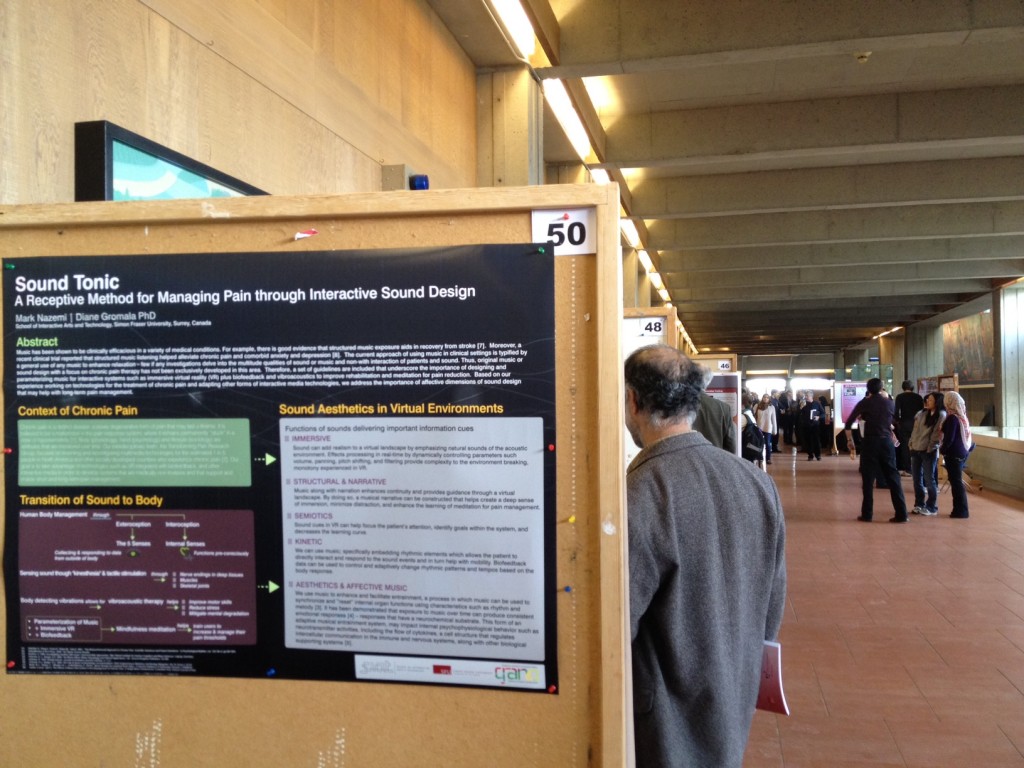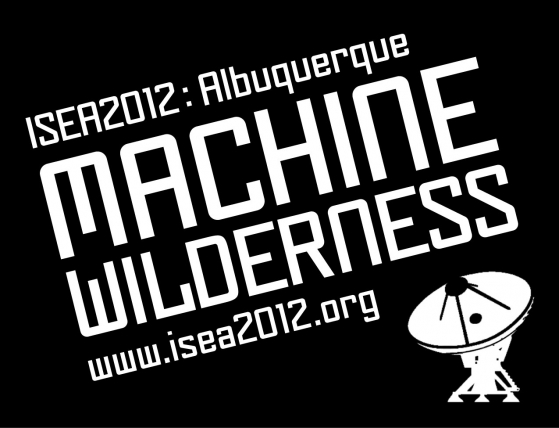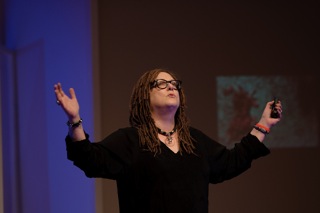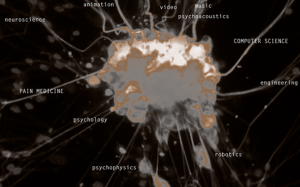Mark Nazemi presented a poster on his proposed research into methods for managing pain through interactive sound design at the SFU Health Networks Health Research Day, on April 12. The poster was co-written by Pain Lab director Dr. Diane Gromala.

Mark Nazemi presented a poster on his proposed research into methods for managing pain through interactive sound design at the SFU Health Networks Health Research Day, on April 12. The poster was co-written by Pain Lab director Dr. Diane Gromala.

Tyler Fox will be giving a workshop at ISEA 2012 (The Eighteenth International Symposium on Electronic Art) in Albuquerque, New Mexico) in September on using bioluminescent dinoflagellates along with physical computing.
Fox will also be in Open Lab, a show at Vancouvers Gallery Gachet in June, 2012. Open Lab involves artwork that encourages, and allows, the audience to change the parameters of the artwork. The show will run in conjunction with a number of workshops at Vancouver Hackspace.

The Transforming Pain Research Group participated in the 2012 SFU Surrey Open House on March 1. A steady stream of visitors dropped by the lab to view the exhibits and posters.
Click here to see more images from Open House 2012.

The Pain Lab will be participating in the annual SFU Surrey Open House on Thursday, February 29. The event takes place 4 p.m. to 8 p.m. Visitors can view our walking virtual meditation project and talk to some of the Pain Lab researchers. Details on the Open House can be found at www.surrey.sfu.ca/openhouse.

PainLab member Terry Lavender is moderating a discussion series on technology and medicine this spring.
The discussions are part of Simon Fraser Universitys Philosophers Cafe, and take place the third Thursday of every month at Barclay Manor in Vancouvers West End. The first talk, Technology and the Elderly: Privacy versus independence, took place in January. Further talks in the series are:
Thu, 16 Feb 2012 7:00 p.m.: Medicine in the cloud
Thu, 15 Mar 2012 7:00 p.m. Pulling the plug
Thu, 19 Apr 2012 7:00 p.m. Health technology: Is it worth the cost?
For more information about the Philosophers’ Cafes, click here.
Mount Qaf, a multimedia performance installation created by the Pain Labs Mark Nazemi and Amir Ghahary, attracted a lot of attention at SIGGRAPH Asia 2011, held in Hong Kong in December 2011.
The piece expresses the aesthetic dimensions of Sufism and electronic music culture, according to Ghahary and Nazemi. According to the SIGGRAPH catalogue description:
Mount Qaf is an audiovisual performance installation and a spatial/temporal structure which expresses the aesthetic dimensions of Sufism and electronic music culture. The experience combines generative digital art based on animating Persian patterns with eastern architectural motifs including Muqarnas, in syncopation with an ethnic electronic soundscape encountered through multi-channel acoustics. By re-imagining the traditional aesthetics of Sufism through the lens of electronic art and digital culture, the visual music journey of Mount Qaf sacralizes a nostalgia for the ancient past as well as reverence for an expectant technological future.
As children of parents who immigrated from Iran, the artists are therefore participating in a space reminiscent of their spiritual heritage while remaining clothed in the fabric of their technological upbringing. In the culture of Persian Sufism, the sense of place which emerges from visual and acoustic aesthetics reflects the alam-i-mithal, or the transcendent Imaginal Realm. To this end, spiritual cultures have always fashioned tools and instruments intended to sacralize space and affect a sense of identity and belonging. Today, electronic and digital media constitute an emerging palette with which the notion of sacred space can be explored. In this way, this multimedia performance installation invites viewers to experience a novel cultural space and consider the mystery surrounding the transcendent sense of home.
Images from The Wild West of Chronic Pain: Collaborations among Artists, Scientists and Health Care Experts
Click here to see images from the recent exhibit at UCLA: The Wild West of Chronic Pain: Collaborations among Artists, Scientists and Health Care Experts.
Diane Gromala spoke at TEDx American Riviera November 11 on Curative Powers of Wet, Raw Beauty. According to the TEDx website, her talk explores the wild side of mindful by creating provocative otherworlds. These virtual reality worlds enable people to access their own curative power in ways that have been measured as an effective non-pharmacological analgesics. Gromala’s work signals one way to address the so-called “silent epidemic” of chronic pain that affects 1 in 5 people — without resorting to the millennia-long use of opioids. A video of her talk can be found here.

The Transforming Pain Research Group, led by Dr. Diane Gromala, will be showing off their stuff at the University of California (Los Angeles) Art | Sci Center + Lab on November 30. Others taking part include Andrea Zeffiro, Tyler Fox and Jay Vidharthi.
Here’s how the announcement on the Art | Sci Center website puts it:
The Wild West of Chronic Pain: Collaborations among Artists, Scientists and Health Care Experts
Members of the Transforming Pain Research Group comprise artists, musicians, computer scientists, engineers, designers, psychophysicists; and pain physicians. All are exploring the ways that new technologies may help the 1 in 5 people who suffer from chronic pain.
Referred to as the silent epidemic, this relatively new disease has no known cause and no cure. While health care researchers explore its etiology, experts from diverse disciplines are working on ways to help with managing chronic pain. See what a group of innovative researchers north of the border are doing.

Lab members Diane Gromala and Terry Lavender attended (via Skype) a Mindfulness Technologies Workshop, held at the Ontario College of Art and Design (OCAD) on November 18. Gromala gave an introduction to CPRM & the lab and discussed immersive virtual reality & mindfulness; while Lavender presented his proposed research on portable mindfulness: immersion and meditation on smart phones and tablets.
Other topics included the effects of mindfulness on pain in adolescents; the effects of mindfulness on pain in adolescents and mindfulness technologies: work in progress. The workshop was organized by OCADs Mobile Experience Lab (http://mobilelab.ca/).